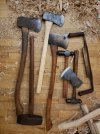- Joined
- Mar 31, 2018
- Messages
- 1,875
Looks perfect to me. I believe you want 20 growth rings per inch for ideal strength. I can't remember the source for that but I'm positive that 20 is the number.Indeed it is straight and tight. Too many rings...?

The BladeForums.com 2024 Traditional Knife is ready to order! See this thread for details:
https://www.bladeforums.com/threads/bladeforums-2024-traditional-knife.2003187/
Price is $300 $250 ea (shipped within CONUS). If you live outside the US, I will contact you after your order for extra shipping charges.
Order here: https://www.bladeforums.com/help/2024-traditional/ - Order as many as you like, we have plenty.
Looks perfect to me. I believe you want 20 growth rings per inch for ideal strength. I can't remember the source for that but I'm positive that 20 is the number.Indeed it is straight and tight. Too many rings...?

It's been bugging me that I've seen that type of jack before, but not in logging. Finally hit me, that it's a wagon jack. As in Conestoga.
As many tools in history evolve from one original practical use use to another, it seems like this one may have too.
I'd love to see some pictures of it in use. It takes a lot of jack to lift a big tree, and how you set it up is crucial to success. There was no doubt some precision chopping to go along with the crosscut saw to set that in right. I wonder what it can lift? Fascinating!
And as to me using it.....no thanks,
I'll take my Silveys.
Looks perfect to me. I believe you want 20 growth rings per inch for ideal strength. I can't remember the source for that but I'm positive that 20 is the number.
The strength of wood is directly related to its weight. So the early to late wood ratio is important and why second growth is prized. It matters much more than counting growth rings.Indeed it is straight and tight. Too many rings...?


That's a beautiful connie! The rest aren't bad either... that vermlands axe is sweet. It's interesting that the markings are on the "off" side of that TT FE. I often wonder why some axes get stamped on the opposite side than what is normal for that co. Beautiful haft on it too!Here's most of the stuff from the last month or so. Two are eBay wins, I'm sure some of you recognize them (sorry if you went for them lol). Left to right there what i believe to be a Kelly Michigan. There's a faint stamp i need to investigate yet. Then a 10lb straight to peen, only stamp is 10. There's a 4lb Plumb rafting I hung using i can't remember what kind of handle. Cut it down to 26". There's a Kelly FE Connie at an interesting 3lbs... Two big ass ball peens, one a 40oz Plumb, the other unmarked. A burly 10" draw knife stamped (to the best of my ability to make it out) L & T.J. White 1837.
And the green one... That was shipped from Sweden. The seller has a picture from an old Hults catalog that looked to be a dead match for a "Vermlands" pattern, listed as being got from the Hults site. But there are no stamps to be found. But it is sooo cool. I'm going to all about this one in more detail in a different thread. 3lb 3oz.
Also not pictured is a 1.5" slick with a stamp i can't recall, but the previous owner had taken the care to stamp both sides with his name, as well.
View attachment 1114059
Beautiful haft on it too!
I think I have a Powell axe made in Cleveland.That's fantastic! I was very glad to find it, especially at the price.
The slick, which I figure is also right up your alley, is a Powell & Co. of Cleveland. I haven't yet looked up whether that was a hardware store or a manufacturer. But a fellow named F.N. Hazen was very possessive of itIt'll be sharpened and put to good use!
Nnnnooooooooooooo! That ruined my weekend! I HATE it when people go sideways and ruin them. Can you reuse it for a Hudson bay or something?I just pulled the haft off. Wood wedge, three wood dowels, and three 2.5" square cut nails. And it all came out relatively easily. Unfortunately the kerf is a shitshow. It's blown out through one side of the tongue.
burly 10" draw knife

White was a company that was established in 1837




